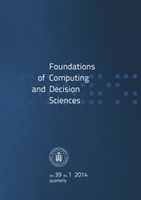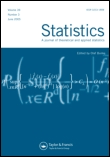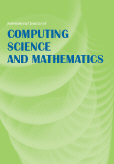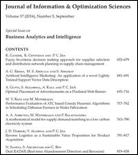
Forecasting
Scope & Guideline
Unlocking the Power of Accurate Forecasting.
Introduction
Aims and Scopes
- Statistical Forecasting Techniques:
The journal emphasizes traditional statistical methods such as ARIMA, exponential smoothing, and regression models, exploring their applications in diverse fields like economics, environmental science, and healthcare. - Machine Learning and AI Integration:
A significant focus is placed on the incorporation of machine learning algorithms, including deep learning and ensemble methods, to improve forecasting accuracy and efficiency in various sectors. - Sector-Specific Applications:
Research often addresses specific sectors such as transportation, energy, finance, and environmental forecasting, showcasing tailored methodologies that meet the unique challenges of each domain. - Comparative Analysis of Forecasting Models:
The journal frequently publishes comparative studies that evaluate the effectiveness of different forecasting models and approaches, contributing to the understanding of model performance across various datasets. - Interdisciplinary Research:
'Forecasting' encourages interdisciplinary studies that combine insights from economics, ecology, technology, and healthcare, fostering a holistic approach to prediction and modeling.
Trending and Emerging
- Hybrid Modeling Approaches:
There is a growing trend towards hybrid models that combine traditional statistical methods with machine learning techniques to enhance forecasting accuracy, reflecting a shift in the complexity and capabilities of forecasting methodologies. - Real-Time and Dynamic Forecasting:
Research focusing on real-time forecasting applications, especially in areas like energy consumption and transportation, is on the rise, highlighting the importance of timely predictions in decision-making processes. - Climate Change and Environmental Forecasting:
As climate change becomes a pressing global issue, studies aimed at forecasting environmental impacts, such as extreme weather events and resource management, are increasingly prevalent. - Health and Epidemiological Forecasting:
The COVID-19 pandemic has spurred interest in health-related forecasting, particularly in modeling disease outbreaks and healthcare resource allocation, indicating a significant emerging theme. - Big Data and Predictive Analytics:
The integration of big data analytics into forecasting methodologies is gaining momentum, with researchers exploring how vast datasets can improve prediction models across various sectors.
Declining or Waning
- Traditional Time Series Analysis:
There has been a noticeable decline in the publication of papers solely focused on classical time series methods without the integration of machine learning or advanced statistical techniques. - Basic Economic Forecasting Models:
Basic economic models that do not incorporate recent technological advancements or complex data structures are increasingly less common, as the field moves toward more sophisticated approaches. - Single-Domain Focus Studies:
Research that concentrates on a singular domain without interdisciplinary connections is waning, as there is a growing preference for studies that incorporate multiple fields and perspectives. - Static Predictive Models:
There is a decrease in interest for static models that do not adapt to changing data patterns, as dynamic and adaptive models are gaining favor for their relevance in real-time forecasting scenarios. - Descriptive Analytics without Predictive Components:
Papers focusing solely on descriptive analytics without offering predictive insights or applications are becoming less frequent, as the journal's emphasis shifts towards actionable forecasting outcomes.
Similar Journals

Foundations of Computing and Decision Sciences
Bridging theory and application for global impact.Foundations of Computing and Decision Sciences, published by SCIENDO, stands as a pivotal platform in the fields of computer science and decision-making theories. Established as an open-access journal since 2012, it facilitates the dissemination of innovative research and insights, catering to a global audience of scholars, practitioners, and students in Germany and beyond. With an ISSN of 0867-6356 and an E-ISSN of 2300-3405, the journal has made significant strides in its ranking, currently positioned in the Q3 category in Computer Science (miscellaneous) and Q4 in Theoretical Computer Science. The journal aims to foster interdisciplinary dialogues and significantly contribute to theoretical and practical advancements within the scope of computing and decision sciences. Its commitment to open access ensures that cutting-edge research is freely available, reinforcing the journal's role as a beacon for academic inquiry and knowledge sharing. With a converging timeline extending to 2024, the journal encourages submissions that address contemporary challenges and breakthroughs across various computing disciplines.

Malaysian Journal of Mathematical Sciences
Advancing Knowledge: Where Mathematics Meets Global CollaborationMalaysian Journal of Mathematical Sciences, published by UNIV PUTRA MALAYSIA PRESS, serves as a prominent platform for the dissemination of innovative research in the field of mathematics. With an ISSN of 1823-8343 and spanning from 2007 to 2024, this journal places a particular emphasis on general mathematics while welcoming contributions that touch on various interdisciplinary applications. Despite its current positioning in Q4 of the mathematics category and ranking #239 out of 399 in Scopus, the journal actively aims to enhance the visibility and impact of mathematical research within Malaysia and the broader academic community. It provides crucial access to emerging ideas, making it an essential resource for researchers, professionals, and students eager to stay abreast of contemporary developments in mathematical sciences. The journal's commitment to open access ensures that findings are readily available to a global audience, fostering collaboration and discussion among scholars worldwide.

STATISTICS
Advancing statistical science for a brighter future.STATISTICS is a distinguished journal published by Taylor & Francis Ltd, dedicated to advancing the field of statistical science since its inception in 1985. With a strong focus on both the theoretical and practical aspects of Statistics and Probability, this journal serves as a vital platform for researchers, professionals, and students seeking to disseminate their findings and contribute to critical discussions in the discipline. Although categorized in the Q3 quartile for both Statistics and Probability and Statistics, Probability and Uncertainty, the journal's commitment to quality research is evidenced by its inclusion in relevant Scopus rankings. It holds respectable positions, ranked #132/168 in Decision Sciences and #219/278 in Mathematics. By providing a venue for high-quality research articles and reviews, STATISTICS aims to foster innovation, reinforce methodological advancements, and address contemporary challenges in statistical applications. The journal does not currently offer open access, but it is widely distributed, ensuring that significant research reaches the communities that need it most. Researchers are encouraged to submit their work to this essential resource that continues to shape the landscape of statistical inquiry.

International Journal of Computing Science and Mathematics
Charting New Territories in Computational Theory and PracticeThe International Journal of Computing Science and Mathematics, published by INDERSCIENCE ENTERPRISES LTD, is a pivotal platform for the dissemination of cutting-edge research in the intertwined disciplines of computing science and mathematics. With an ISSN of 1752-5055 and an E-ISSN of 1752-5063, the journal primarily serves the academic community engaged in applied mathematics, computational mathematics, theoretical computer science, and more, making significant contributions that resonate across various fields of technology and science. While the journal is currently categorized in the Q4 quartile for multiple related fields, including Applied Mathematics and Computational Theory, it continues to strive towards advancing the knowledge and practice within these areas. Spanning years from 2007 to 2010 and again from 2012 to 2024, the journal seeks to publish high-quality, peer-reviewed articles that not only address theoretical advancements but also explore practical applications of computing science in mathematical contexts, thereby fostering collaboration among researchers, professionals, and students alike. Please note that this journal is not available as Open Access, thus ensuring a curated content selection intended for dedicated research communities.

STATISTICAL MODELLING
Empowering Research Through Rigorous Statistical AnalysisSTATISTICAL MODELLING, published by SAGE Publications Ltd in the United Kingdom, is a prominent peer-reviewed journal dedicated to the evolving domain of statistics and its application in various scientific fields. With the ISSN 1471-082X and E-ISSN 1477-0342, this journal serves as a vital platform for researchers and practitioners to disseminate innovative methodologies, theoretical advancements, and practical applications pertaining to statistical modelling. Covering research from 2001 to 2024, the journal consistently contributes to the discourse within the Q3 quartile in both Statistics and Probability and Statistics, Probability and Uncertainty categories. Furthermore, it ranks in the 54th percentile for Mathematics - Statistics and Probability and in the 53rd percentile for Decision Sciences, reflecting its growing reputational value among academic peers. Although this journal does not include Open Access options, its rigorous selection process and scholarly contributions ensure that it remains an essential resource for statistical research. Researchers, professionals, and students alike will find STATISTICAL MODELLING to be an indispensable reference for advancing their understanding and application of statistical techniques.

Matematika
Elevating Mathematical Discourse Across BordersMatematika, an esteemed journal published by PENERBIT UTM PRESS, serves as a pivotal platform for showcasing innovative research in the field of mathematics. With the ISSN 0127-8274, this publication is dedicated to advancing mathematical knowledge and its applications, making significant contributions to both theoretical and applied mathematics. Although currently not offering open access, the journal is recognized for its rigorous peer-review process, ensuring the quality and integrity of published works. With its base in Skudai, Johor, Malaysia, Matematika plays a crucial role in promoting mathematical literacy and research within the ASEAN region and beyond. It invites researchers, professionals, and students to explore and contribute to the vibrant discussions that shape the future of mathematics.

Data Science and Engineering
Exploring the intersection of data science and engineering.Data Science and Engineering is a premier open access journal published by SPRINGERNATURE, dedicated to advancing the fields of data science, artificial intelligence, computational mechanics, and information systems. Since its inception in 2016, this journal has rapidly established itself as a leader in the academic community, boasting an impressive Q1 ranking in multiple computer science categories, including Artificial Intelligence, Software, and Information Systems. With a commitment to disseminating high-quality research, it caters to a diverse audience of researchers, professionals, and students eager to explore the intersection of data and technology. The journal's robust global reach, combined with its respected reputation, empowers authors to share their findings widely, facilitating breakthroughs and innovations across the digital landscape. Join the vibrant community of scholars contributing to this integral field of study, and stay informed with the latest research by accessing the journal freely online.

JOURNAL OF INFORMATION & OPTIMIZATION SCIENCES
Empowering innovation through mathematical excellence.JOURNAL OF INFORMATION & OPTIMIZATION SCIENCES, published by TARU PUBLICATIONS, is a vital platform for researchers and practitioners in the field of information science and optimization techniques. With a focus on the application of mathematical and computational methods to solve complex problems in various domains, this journal aims to advance knowledge and encourage innovative thinking. The journal's ISSN is 0252-2667 and the E-ISSN is 2169-0103. Although currently not Open Access, it strives to provide high-quality research that significantly contributes to the industry. With a commitment to rigor and excellence, the JOURNAL OF INFORMATION & OPTIMIZATION SCIENCES is essential for anyone dedicated to enhancing their understanding and application of optimization methodologies in an ever-evolving technological landscape.

Earth Science Informatics
Empowering Earth Science with Cutting-Edge Informatics.Earth Science Informatics, published by SPRINGER HEIDELBERG, serves as a premier platform for disseminating innovative research in the realm of Earth and Planetary Sciences. With an ISSN of 1865-0473 and an E-ISSN of 1865-0481, this journal offers insightful contributions that leverage informatics and data-driven approaches to address complex geoscientific challenges. As a testament to its impact in the field, it ranks in the Q2 quartile and holds an impressive 73rd percentile rank among 195 journals in the broader **Earth and Planetary Sciences** category, as per Scopus rankings. This journal invites researchers, professionals, and students to explore and contribute to the growing body of knowledge that bridges the gap between informatics and Earth science, fostering advancements in both theoretical frameworks and practical applications. Situated in Germany, at TIERGARTENSTRASSE 17, D-69121 HEIDELBERG, it aims to enhance interdisciplinary collaboration and propel scientific discovery from 2009 to 2024 and beyond, reinforcing its vital role in the academic community.

SIAM Journal on Mathematics of Data Science
Bridging Theory and Application in Data ScienceSIAM Journal on Mathematics of Data Science is an esteemed publication within the fields of applied mathematics and data science, published by SIAM PUBLICATIONS. This journal serves as a vital platform for researchers and practitioners, dedicated to disseminating high-quality research that addresses complex mathematical problems arising in the context of data science. The journal aims to bridge the gap between rigorous mathematical theory and practical applications, fostering interdisciplinary collaboration among mathematicians, data scientists, and statisticians. With its commitment to excellence, the SIAM Journal on Mathematics of Data Science contributes significantly to advancing the understanding and development of mathematical methodologies that analyze and interpret large datasets effectively. Researchers and professionals will find it an invaluable resource with its comprehensive articles, insightful reviews, and original research papers, which represent the forefront of innovative mathematical approaches in the evolving landscape of data science. For those interested in contributing to this dynamic field, the journal provides an array of access options tailored to diverse audiences.